A Comprehensive Analysis of Australia's Four-Pillar Banking Policy
VerifiedAdded on 2022/09/14
|14
|3475
|10
Report
AI Summary
This report provides a detailed analysis of Australia's Four-Pillar Policy, a government initiative designed to maintain separation among the four largest banks. It begins with an executive summary outlining the policy's purpose, history, and the arguments surrounding it. The report delves into the history of the policy, tracing its origins and implementation by the Australian government. It examines the arguments both in favor of and against the policy, considering its impact on competition, financial stability, and the broader banking landscape. Furthermore, the report presents an opinion on the policy's relevance in the current business environment, concluding with a recommendation on whether the government should maintain, amend, or abandon the policy based on the analysis of its advantages and disadvantages. The report emphasizes the policy's impact on the financial industry and its effects on the competitive environment of the banking sector.
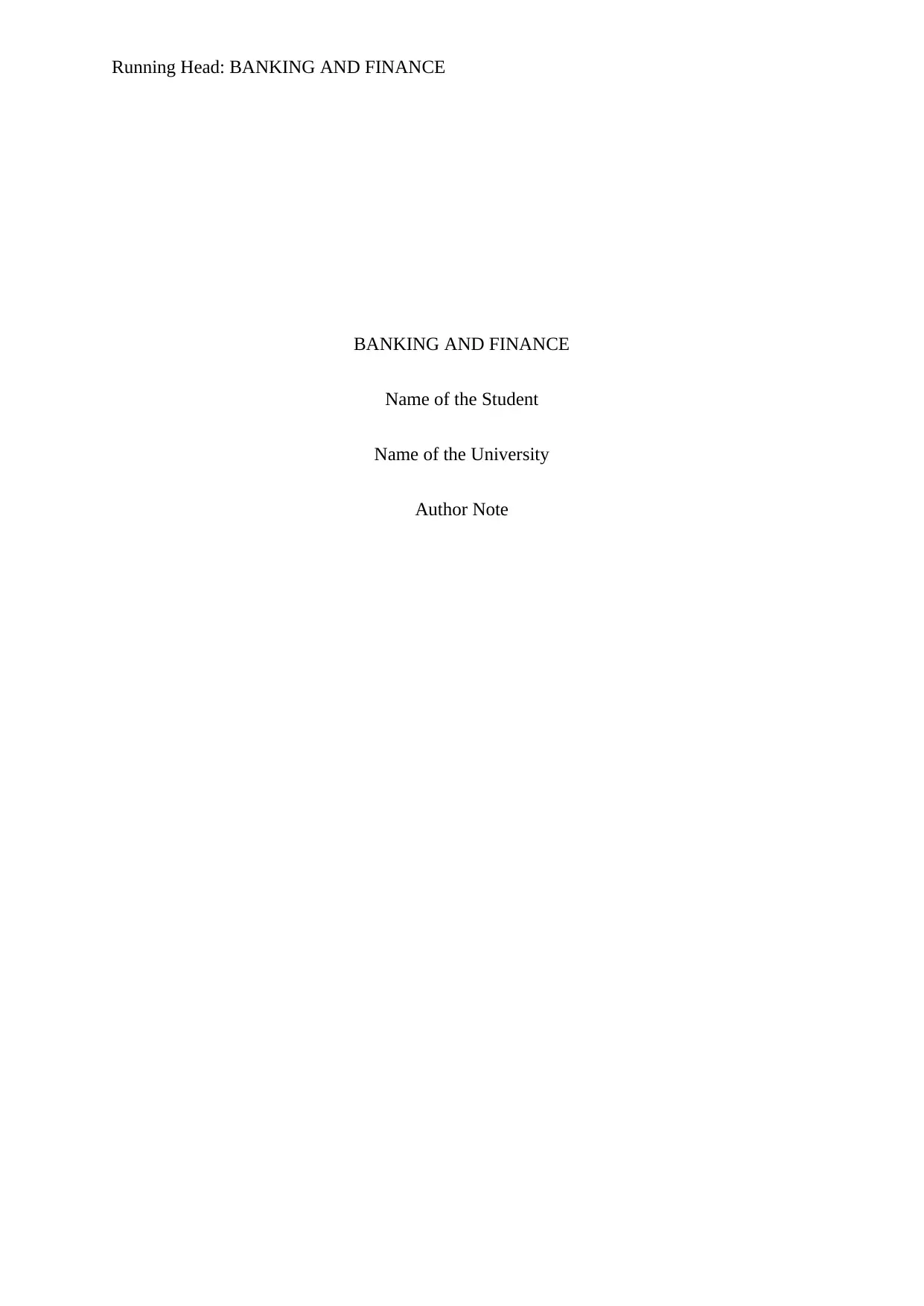
Running Head: BANKING AND FINANCE
BANKING AND FINANCE
Name of the Student
Name of the University
Author Note
BANKING AND FINANCE
Name of the Student
Name of the University
Author Note
Paraphrase This Document
Need a fresh take? Get an instant paraphrase of this document with our AI Paraphraser
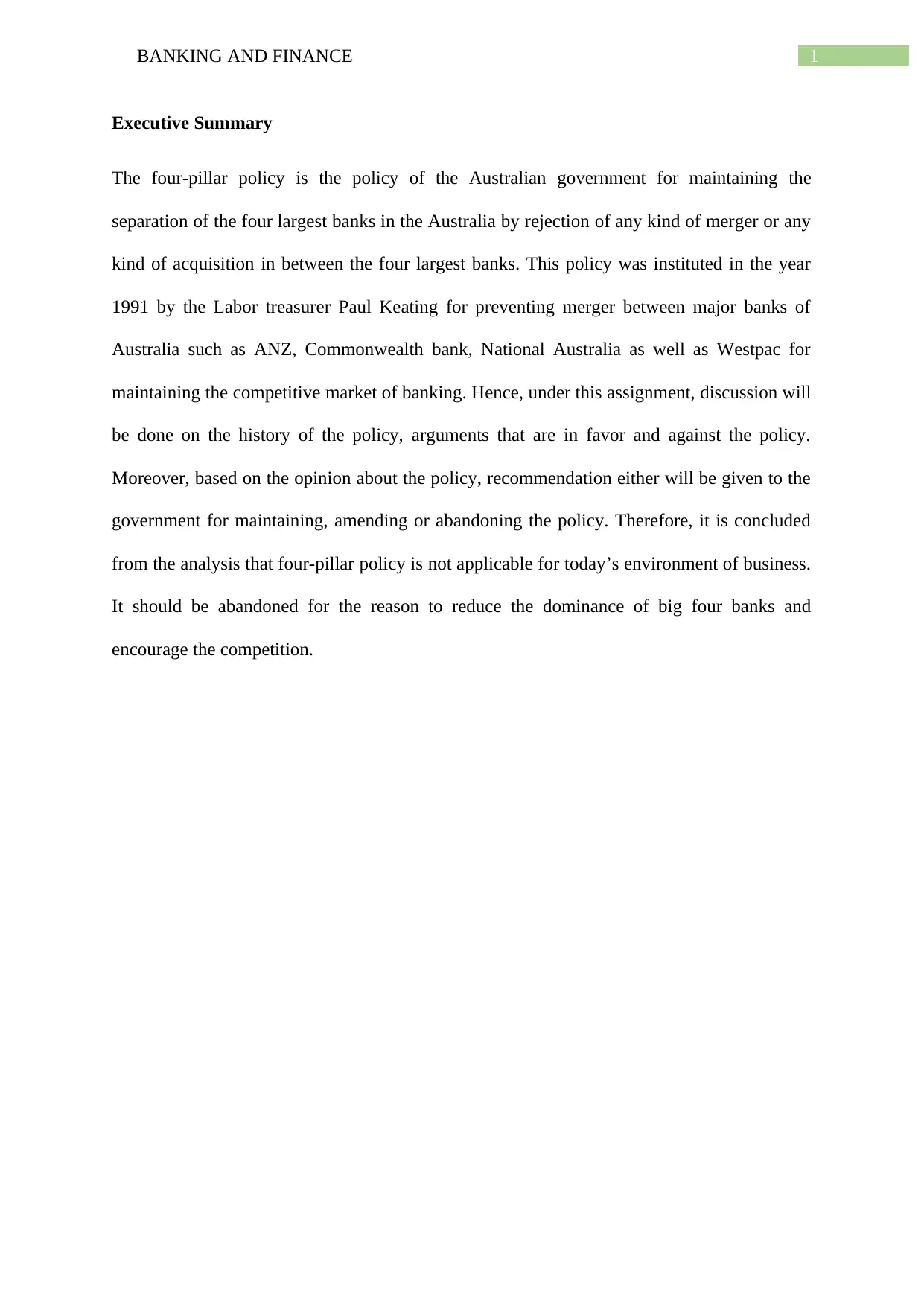
1BANKING AND FINANCE
Executive Summary
The four-pillar policy is the policy of the Australian government for maintaining the
separation of the four largest banks in the Australia by rejection of any kind of merger or any
kind of acquisition in between the four largest banks. This policy was instituted in the year
1991 by the Labor treasurer Paul Keating for preventing merger between major banks of
Australia such as ANZ, Commonwealth bank, National Australia as well as Westpac for
maintaining the competitive market of banking. Hence, under this assignment, discussion will
be done on the history of the policy, arguments that are in favor and against the policy.
Moreover, based on the opinion about the policy, recommendation either will be given to the
government for maintaining, amending or abandoning the policy. Therefore, it is concluded
from the analysis that four-pillar policy is not applicable for today’s environment of business.
It should be abandoned for the reason to reduce the dominance of big four banks and
encourage the competition.
Executive Summary
The four-pillar policy is the policy of the Australian government for maintaining the
separation of the four largest banks in the Australia by rejection of any kind of merger or any
kind of acquisition in between the four largest banks. This policy was instituted in the year
1991 by the Labor treasurer Paul Keating for preventing merger between major banks of
Australia such as ANZ, Commonwealth bank, National Australia as well as Westpac for
maintaining the competitive market of banking. Hence, under this assignment, discussion will
be done on the history of the policy, arguments that are in favor and against the policy.
Moreover, based on the opinion about the policy, recommendation either will be given to the
government for maintaining, amending or abandoning the policy. Therefore, it is concluded
from the analysis that four-pillar policy is not applicable for today’s environment of business.
It should be abandoned for the reason to reduce the dominance of big four banks and
encourage the competition.

2BANKING AND FINANCE
Table of Contents
Introduction................................................................................................................................3
Discussion..................................................................................................................................3
History of Four Pillar Policy..................................................................................................3
Institution and Implementation of Policy...............................................................................4
Arguments Related to Four Pillar Policy...............................................................................5
Opinion Regarding Four Pillar Policy....................................................................................8
Conclusion and Recommendation..............................................................................................9
Reference..................................................................................................................................11
Table of Contents
Introduction................................................................................................................................3
Discussion..................................................................................................................................3
History of Four Pillar Policy..................................................................................................3
Institution and Implementation of Policy...............................................................................4
Arguments Related to Four Pillar Policy...............................................................................5
Opinion Regarding Four Pillar Policy....................................................................................8
Conclusion and Recommendation..............................................................................................9
Reference..................................................................................................................................11
⊘ This is a preview!⊘
Do you want full access?
Subscribe today to unlock all pages.

Trusted by 1+ million students worldwide
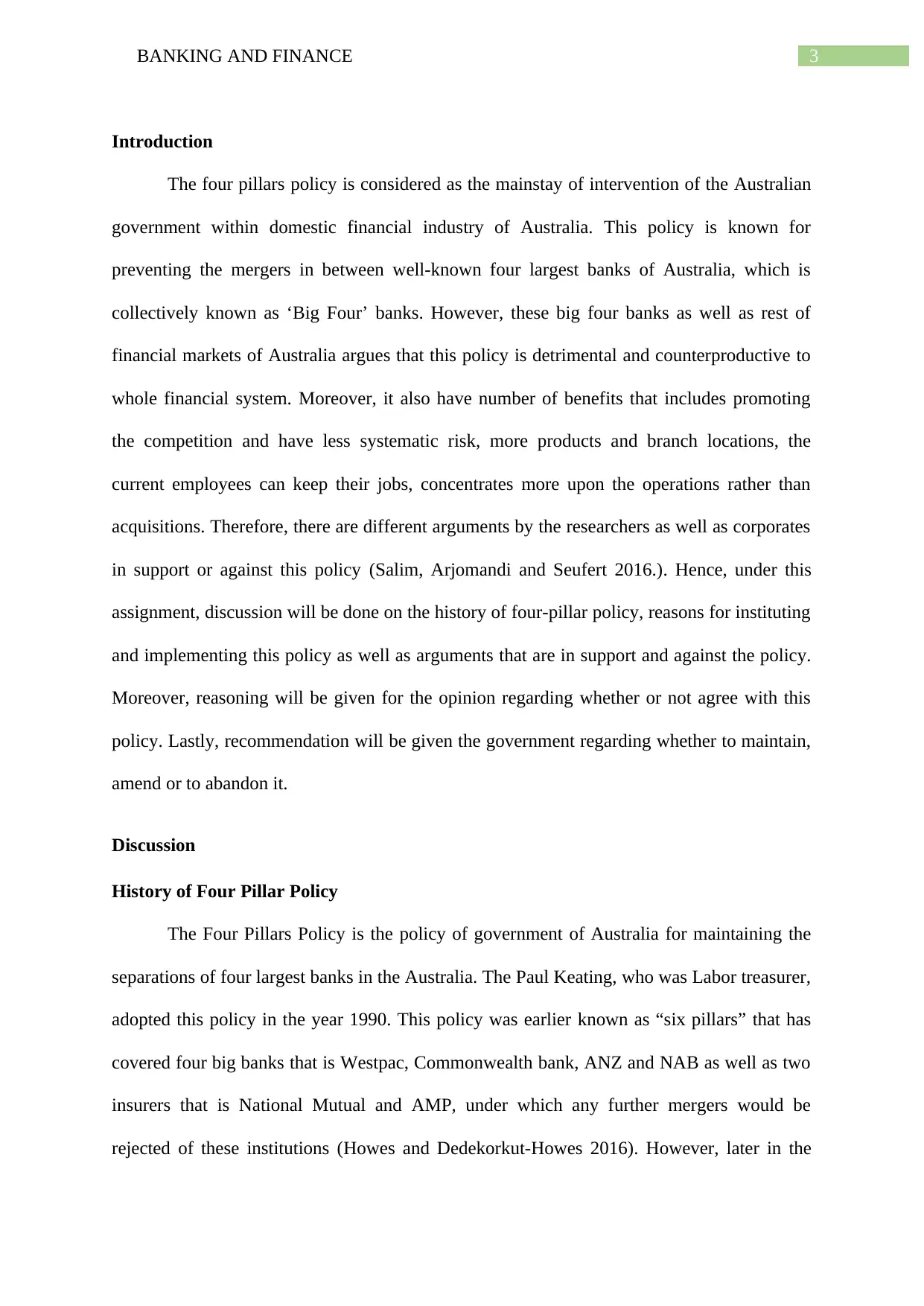
3BANKING AND FINANCE
Introduction
The four pillars policy is considered as the mainstay of intervention of the Australian
government within domestic financial industry of Australia. This policy is known for
preventing the mergers in between well-known four largest banks of Australia, which is
collectively known as ‘Big Four’ banks. However, these big four banks as well as rest of
financial markets of Australia argues that this policy is detrimental and counterproductive to
whole financial system. Moreover, it also have number of benefits that includes promoting
the competition and have less systematic risk, more products and branch locations, the
current employees can keep their jobs, concentrates more upon the operations rather than
acquisitions. Therefore, there are different arguments by the researchers as well as corporates
in support or against this policy (Salim, Arjomandi and Seufert 2016.). Hence, under this
assignment, discussion will be done on the history of four-pillar policy, reasons for instituting
and implementing this policy as well as arguments that are in support and against the policy.
Moreover, reasoning will be given for the opinion regarding whether or not agree with this
policy. Lastly, recommendation will be given the government regarding whether to maintain,
amend or to abandon it.
Discussion
History of Four Pillar Policy
The Four Pillars Policy is the policy of government of Australia for maintaining the
separations of four largest banks in the Australia. The Paul Keating, who was Labor treasurer,
adopted this policy in the year 1990. This policy was earlier known as “six pillars” that has
covered four big banks that is Westpac, Commonwealth bank, ANZ and NAB as well as two
insurers that is National Mutual and AMP, under which any further mergers would be
rejected of these institutions (Howes and Dedekorkut-Howes 2016). However, later in the
Introduction
The four pillars policy is considered as the mainstay of intervention of the Australian
government within domestic financial industry of Australia. This policy is known for
preventing the mergers in between well-known four largest banks of Australia, which is
collectively known as ‘Big Four’ banks. However, these big four banks as well as rest of
financial markets of Australia argues that this policy is detrimental and counterproductive to
whole financial system. Moreover, it also have number of benefits that includes promoting
the competition and have less systematic risk, more products and branch locations, the
current employees can keep their jobs, concentrates more upon the operations rather than
acquisitions. Therefore, there are different arguments by the researchers as well as corporates
in support or against this policy (Salim, Arjomandi and Seufert 2016.). Hence, under this
assignment, discussion will be done on the history of four-pillar policy, reasons for instituting
and implementing this policy as well as arguments that are in support and against the policy.
Moreover, reasoning will be given for the opinion regarding whether or not agree with this
policy. Lastly, recommendation will be given the government regarding whether to maintain,
amend or to abandon it.
Discussion
History of Four Pillar Policy
The Four Pillars Policy is the policy of government of Australia for maintaining the
separations of four largest banks in the Australia. The Paul Keating, who was Labor treasurer,
adopted this policy in the year 1990. This policy was earlier known as “six pillars” that has
covered four big banks that is Westpac, Commonwealth bank, ANZ and NAB as well as two
insurers that is National Mutual and AMP, under which any further mergers would be
rejected of these institutions (Howes and Dedekorkut-Howes 2016). However, later in the
Paraphrase This Document
Need a fresh take? Get an instant paraphrase of this document with our AI Paraphraser

4BANKING AND FINANCE
year 1997, the leading business figure has produced the report of the inquiry into the financial
system of the Australia that is “the Wallis report”, in which he has recommended that the
model of “Four Pillar” should be dismantled for leaving the banks that are subject to same
competition test of merger as the other business. In this response, Peter Costello who is the
Coalition Treasurer, has removed pillar status of the two insurers but the ban on the mergers
of four banks was retained, considering that none of these four banks immune from the
foreign takeovers. Moreover, with the change of the government, the new Treasurer Wayne
Swan has stated in the year 2008 that the Labor Government has no plans for dismantling the
four-pillar policy (Pha 2017).
Institution and Implementation of Policy
The Four pillars policy is that informal policy that is designed for preventing the
mergers between or the acquisitions among four largest banking institutions of Australia.
These four big banks are composed of National Australian Bank, Westpac Group,
Commonwealth Bank of Australia as well as Australia and New Zealand banking Group.
Based on the data of the year 2010, the big four banks comprises of total 56.3% of the total
Australian financial industry and the total of 76.1% of the total banking transactions within
Australia. Moreover, the data of the year, also shows that the estimate of 82.88% of all the
lending, total amount of 25.9% of the total funds of the investment as well as 57.3% of the
retail funds under the administrations that are controlled by the big four banks (Sam and
Tiong 2015).
The preponderance of big four banks in financial industry of Australia necessitates the
special regulations for these particular banks as it is exemplified by Four pillars policy. The
routine financial consolidation of the Australia is in the purview of the Australian Prudential
Regulation Authority as well as Australian Competition and the Consumer Commission,
which are the subordinate agencies of treasury of Australia. These agencies help in
year 1997, the leading business figure has produced the report of the inquiry into the financial
system of the Australia that is “the Wallis report”, in which he has recommended that the
model of “Four Pillar” should be dismantled for leaving the banks that are subject to same
competition test of merger as the other business. In this response, Peter Costello who is the
Coalition Treasurer, has removed pillar status of the two insurers but the ban on the mergers
of four banks was retained, considering that none of these four banks immune from the
foreign takeovers. Moreover, with the change of the government, the new Treasurer Wayne
Swan has stated in the year 2008 that the Labor Government has no plans for dismantling the
four-pillar policy (Pha 2017).
Institution and Implementation of Policy
The Four pillars policy is that informal policy that is designed for preventing the
mergers between or the acquisitions among four largest banking institutions of Australia.
These four big banks are composed of National Australian Bank, Westpac Group,
Commonwealth Bank of Australia as well as Australia and New Zealand banking Group.
Based on the data of the year 2010, the big four banks comprises of total 56.3% of the total
Australian financial industry and the total of 76.1% of the total banking transactions within
Australia. Moreover, the data of the year, also shows that the estimate of 82.88% of all the
lending, total amount of 25.9% of the total funds of the investment as well as 57.3% of the
retail funds under the administrations that are controlled by the big four banks (Sam and
Tiong 2015).
The preponderance of big four banks in financial industry of Australia necessitates the
special regulations for these particular banks as it is exemplified by Four pillars policy. The
routine financial consolidation of the Australia is in the purview of the Australian Prudential
Regulation Authority as well as Australian Competition and the Consumer Commission,
which are the subordinate agencies of treasury of Australia. These agencies help in
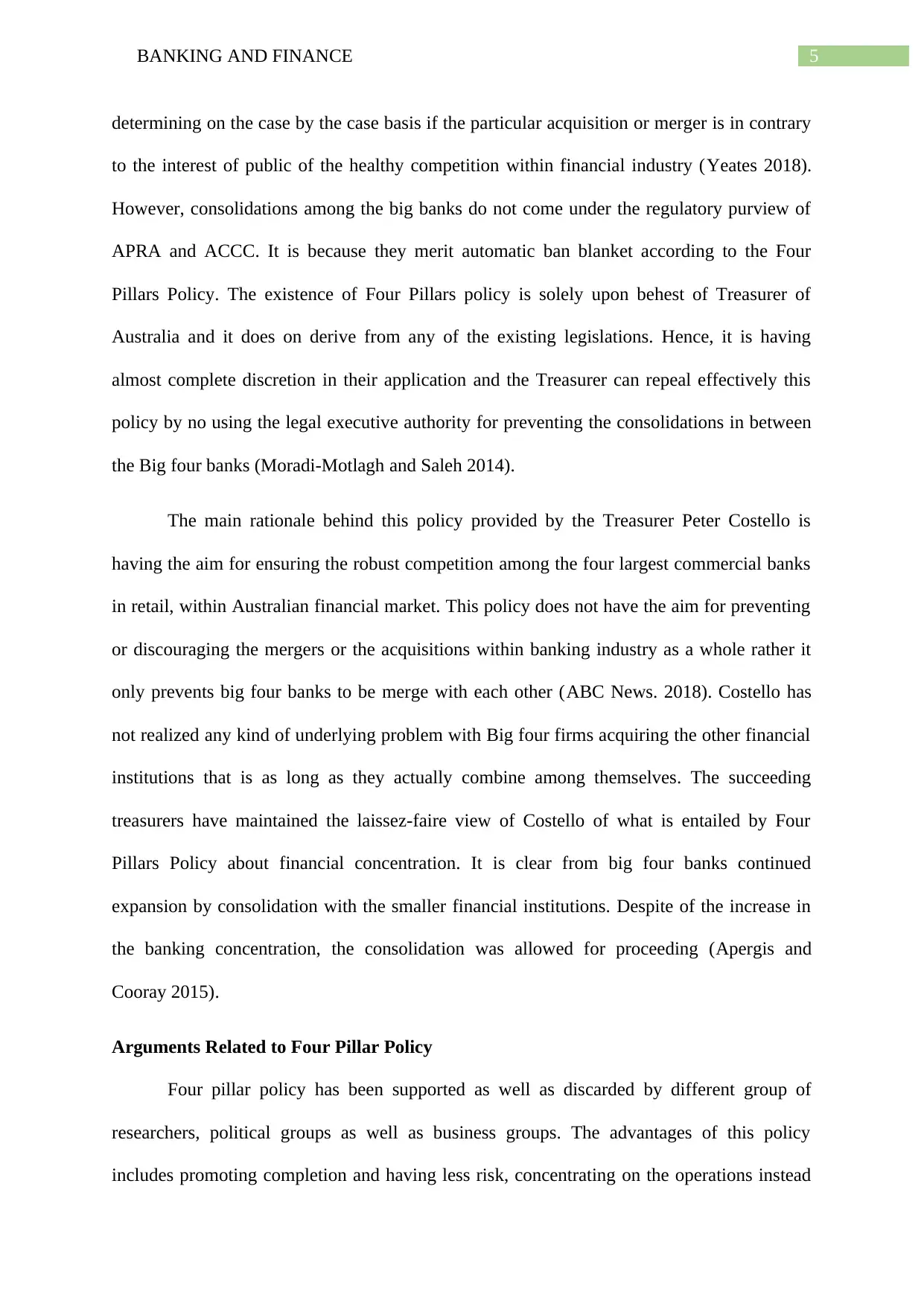
5BANKING AND FINANCE
determining on the case by the case basis if the particular acquisition or merger is in contrary
to the interest of public of the healthy competition within financial industry (Yeates 2018).
However, consolidations among the big banks do not come under the regulatory purview of
APRA and ACCC. It is because they merit automatic ban blanket according to the Four
Pillars Policy. The existence of Four Pillars policy is solely upon behest of Treasurer of
Australia and it does on derive from any of the existing legislations. Hence, it is having
almost complete discretion in their application and the Treasurer can repeal effectively this
policy by no using the legal executive authority for preventing the consolidations in between
the Big four banks (Moradi‐Motlagh and Saleh 2014).
The main rationale behind this policy provided by the Treasurer Peter Costello is
having the aim for ensuring the robust competition among the four largest commercial banks
in retail, within Australian financial market. This policy does not have the aim for preventing
or discouraging the mergers or the acquisitions within banking industry as a whole rather it
only prevents big four banks to be merge with each other (ABC News. 2018). Costello has
not realized any kind of underlying problem with Big four firms acquiring the other financial
institutions that is as long as they actually combine among themselves. The succeeding
treasurers have maintained the laissez-faire view of Costello of what is entailed by Four
Pillars Policy about financial concentration. It is clear from big four banks continued
expansion by consolidation with the smaller financial institutions. Despite of the increase in
the banking concentration, the consolidation was allowed for proceeding (Apergis and
Cooray 2015).
Arguments Related to Four Pillar Policy
Four pillar policy has been supported as well as discarded by different group of
researchers, political groups as well as business groups. The advantages of this policy
includes promoting completion and having less risk, concentrating on the operations instead
determining on the case by the case basis if the particular acquisition or merger is in contrary
to the interest of public of the healthy competition within financial industry (Yeates 2018).
However, consolidations among the big banks do not come under the regulatory purview of
APRA and ACCC. It is because they merit automatic ban blanket according to the Four
Pillars Policy. The existence of Four Pillars policy is solely upon behest of Treasurer of
Australia and it does on derive from any of the existing legislations. Hence, it is having
almost complete discretion in their application and the Treasurer can repeal effectively this
policy by no using the legal executive authority for preventing the consolidations in between
the Big four banks (Moradi‐Motlagh and Saleh 2014).
The main rationale behind this policy provided by the Treasurer Peter Costello is
having the aim for ensuring the robust competition among the four largest commercial banks
in retail, within Australian financial market. This policy does not have the aim for preventing
or discouraging the mergers or the acquisitions within banking industry as a whole rather it
only prevents big four banks to be merge with each other (ABC News. 2018). Costello has
not realized any kind of underlying problem with Big four firms acquiring the other financial
institutions that is as long as they actually combine among themselves. The succeeding
treasurers have maintained the laissez-faire view of Costello of what is entailed by Four
Pillars Policy about financial concentration. It is clear from big four banks continued
expansion by consolidation with the smaller financial institutions. Despite of the increase in
the banking concentration, the consolidation was allowed for proceeding (Apergis and
Cooray 2015).
Arguments Related to Four Pillar Policy
Four pillar policy has been supported as well as discarded by different group of
researchers, political groups as well as business groups. The advantages of this policy
includes promoting completion and having less risk, concentrating on the operations instead
⊘ This is a preview!⊘
Do you want full access?
Subscribe today to unlock all pages.

Trusted by 1+ million students worldwide
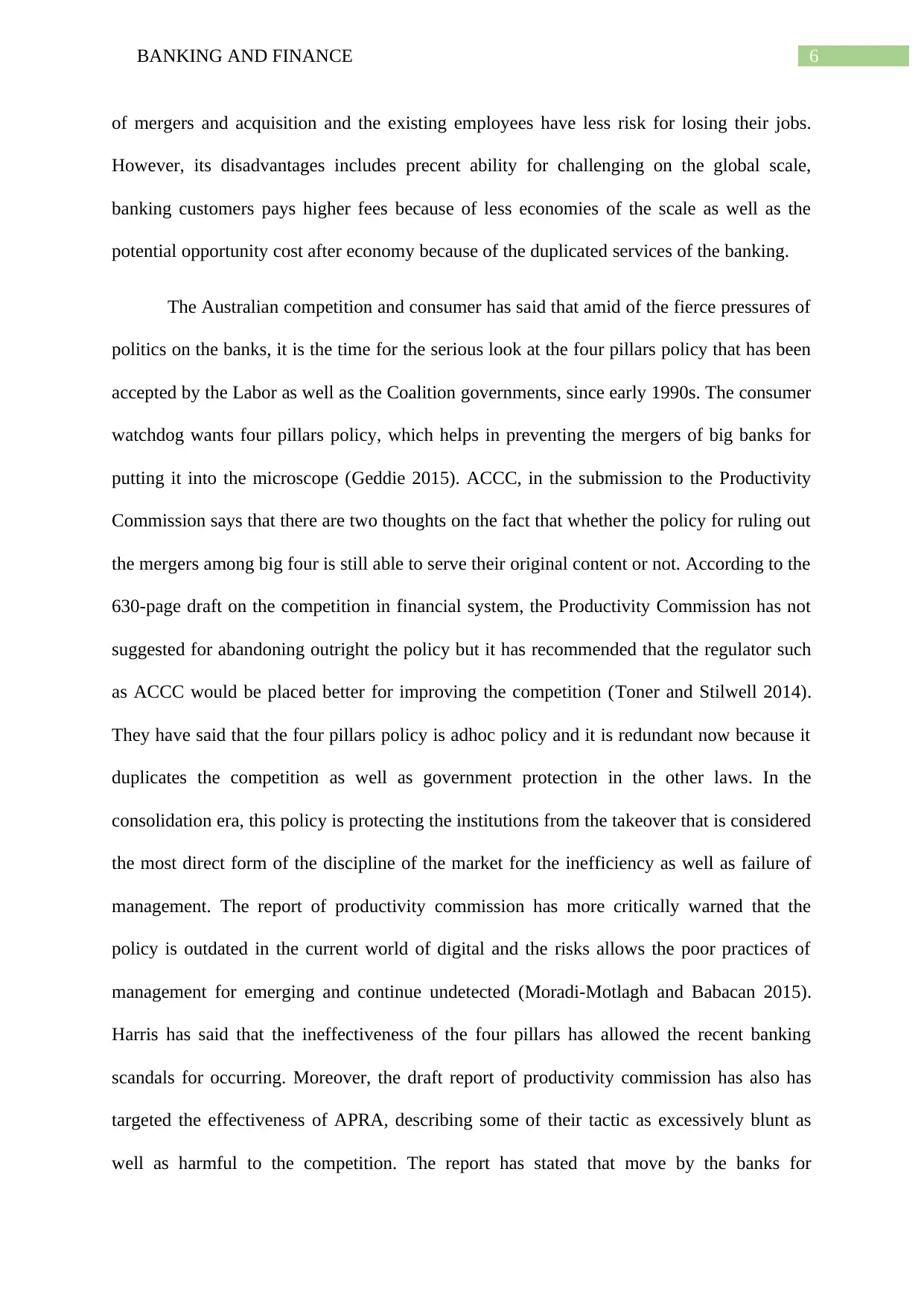
6BANKING AND FINANCE
of mergers and acquisition and the existing employees have less risk for losing their jobs.
However, its disadvantages includes precent ability for challenging on the global scale,
banking customers pays higher fees because of less economies of the scale as well as the
potential opportunity cost after economy because of the duplicated services of the banking.
The Australian competition and consumer has said that amid of the fierce pressures of
politics on the banks, it is the time for the serious look at the four pillars policy that has been
accepted by the Labor as well as the Coalition governments, since early 1990s. The consumer
watchdog wants four pillars policy, which helps in preventing the mergers of big banks for
putting it into the microscope (Geddie 2015). ACCC, in the submission to the Productivity
Commission says that there are two thoughts on the fact that whether the policy for ruling out
the mergers among big four is still able to serve their original content or not. According to the
630-page draft on the competition in financial system, the Productivity Commission has not
suggested for abandoning outright the policy but it has recommended that the regulator such
as ACCC would be placed better for improving the competition (Toner and Stilwell 2014).
They have said that the four pillars policy is adhoc policy and it is redundant now because it
duplicates the competition as well as government protection in the other laws. In the
consolidation era, this policy is protecting the institutions from the takeover that is considered
the most direct form of the discipline of the market for the inefficiency as well as failure of
management. The report of productivity commission has more critically warned that the
policy is outdated in the current world of digital and the risks allows the poor practices of
management for emerging and continue undetected (Moradi-Motlagh and Babacan 2015).
Harris has said that the ineffectiveness of the four pillars has allowed the recent banking
scandals for occurring. Moreover, the draft report of productivity commission has also has
targeted the effectiveness of APRA, describing some of their tactic as excessively blunt as
well as harmful to the competition. The report has stated that move by the banks for
of mergers and acquisition and the existing employees have less risk for losing their jobs.
However, its disadvantages includes precent ability for challenging on the global scale,
banking customers pays higher fees because of less economies of the scale as well as the
potential opportunity cost after economy because of the duplicated services of the banking.
The Australian competition and consumer has said that amid of the fierce pressures of
politics on the banks, it is the time for the serious look at the four pillars policy that has been
accepted by the Labor as well as the Coalition governments, since early 1990s. The consumer
watchdog wants four pillars policy, which helps in preventing the mergers of big banks for
putting it into the microscope (Geddie 2015). ACCC, in the submission to the Productivity
Commission says that there are two thoughts on the fact that whether the policy for ruling out
the mergers among big four is still able to serve their original content or not. According to the
630-page draft on the competition in financial system, the Productivity Commission has not
suggested for abandoning outright the policy but it has recommended that the regulator such
as ACCC would be placed better for improving the competition (Toner and Stilwell 2014).
They have said that the four pillars policy is adhoc policy and it is redundant now because it
duplicates the competition as well as government protection in the other laws. In the
consolidation era, this policy is protecting the institutions from the takeover that is considered
the most direct form of the discipline of the market for the inefficiency as well as failure of
management. The report of productivity commission has more critically warned that the
policy is outdated in the current world of digital and the risks allows the poor practices of
management for emerging and continue undetected (Moradi-Motlagh and Babacan 2015).
Harris has said that the ineffectiveness of the four pillars has allowed the recent banking
scandals for occurring. Moreover, the draft report of productivity commission has also has
targeted the effectiveness of APRA, describing some of their tactic as excessively blunt as
well as harmful to the competition. The report has stated that move by the banks for
Paraphrase This Document
Need a fresh take? Get an instant paraphrase of this document with our AI Paraphraser

7BANKING AND FINANCE
collectively raising the rates of interest on the loans of the investors has resulted in the
investor borrowers deducting the part of additional costs that ultimately costs the taxpayers to
the amount of $500million. In the wider range of the report, the commission has tackled the
banks for not lowering fully the costs of borrowing that is in spite of cash rate of Reserve
bank falling for recording the low of 1.5 per cent. In the recent years, the spread in between
the home loans as well as cash rate has increased largely. The draft has said that the financial
system of Australia needs competition champion and none of the regulators of Australia has
the mandate for properly fulfilling their role (Rao 2016).
However, apart from various arguments against the Four Pillar Policy, there are
certain arguments that are in favor of this policy. Ian Macfarlane, who was the former
governor of the Reserve Bank, has credited the four pillars policy in order to prohibit the
takeovers between the big four banks with the protection of local lenders from sweeping
turmoil by the financial system of world. He stated that the key reason behind the relative
strength of banks of Australia was the fact that the ban of the Federal government on the
mergers between big four firms has avoided the destructive form of the competitions seen
overseas (Bollen, Skully and Wei 2014). The policy prevents the mergers in between the
major lenders right since the year 1990 for competition and it is not been replicated in the
country of US or Europe and Britain. The board member of the ANZ Bank, Macfarlane has
said that the absence of the regulation in the overseas has caused the lenders for focusing
excessively on the snapping up the smaller rival for the rapid and higher growth for avoiding
to become a target of takeover. In contrast, this policy has encouraged the Australian banks
for being more prudent in years of boom. He has said that the four-pillar policy has made the
great contribution for the improvement in stability of the financial system. This is not because
it has increased the competition rather it has reduced it
(Financialservices.royalcommission.gov.au. 2019).
collectively raising the rates of interest on the loans of the investors has resulted in the
investor borrowers deducting the part of additional costs that ultimately costs the taxpayers to
the amount of $500million. In the wider range of the report, the commission has tackled the
banks for not lowering fully the costs of borrowing that is in spite of cash rate of Reserve
bank falling for recording the low of 1.5 per cent. In the recent years, the spread in between
the home loans as well as cash rate has increased largely. The draft has said that the financial
system of Australia needs competition champion and none of the regulators of Australia has
the mandate for properly fulfilling their role (Rao 2016).
However, apart from various arguments against the Four Pillar Policy, there are
certain arguments that are in favor of this policy. Ian Macfarlane, who was the former
governor of the Reserve Bank, has credited the four pillars policy in order to prohibit the
takeovers between the big four banks with the protection of local lenders from sweeping
turmoil by the financial system of world. He stated that the key reason behind the relative
strength of banks of Australia was the fact that the ban of the Federal government on the
mergers between big four firms has avoided the destructive form of the competitions seen
overseas (Bollen, Skully and Wei 2014). The policy prevents the mergers in between the
major lenders right since the year 1990 for competition and it is not been replicated in the
country of US or Europe and Britain. The board member of the ANZ Bank, Macfarlane has
said that the absence of the regulation in the overseas has caused the lenders for focusing
excessively on the snapping up the smaller rival for the rapid and higher growth for avoiding
to become a target of takeover. In contrast, this policy has encouraged the Australian banks
for being more prudent in years of boom. He has said that the four-pillar policy has made the
great contribution for the improvement in stability of the financial system. This is not because
it has increased the competition rather it has reduced it
(Financialservices.royalcommission.gov.au. 2019).
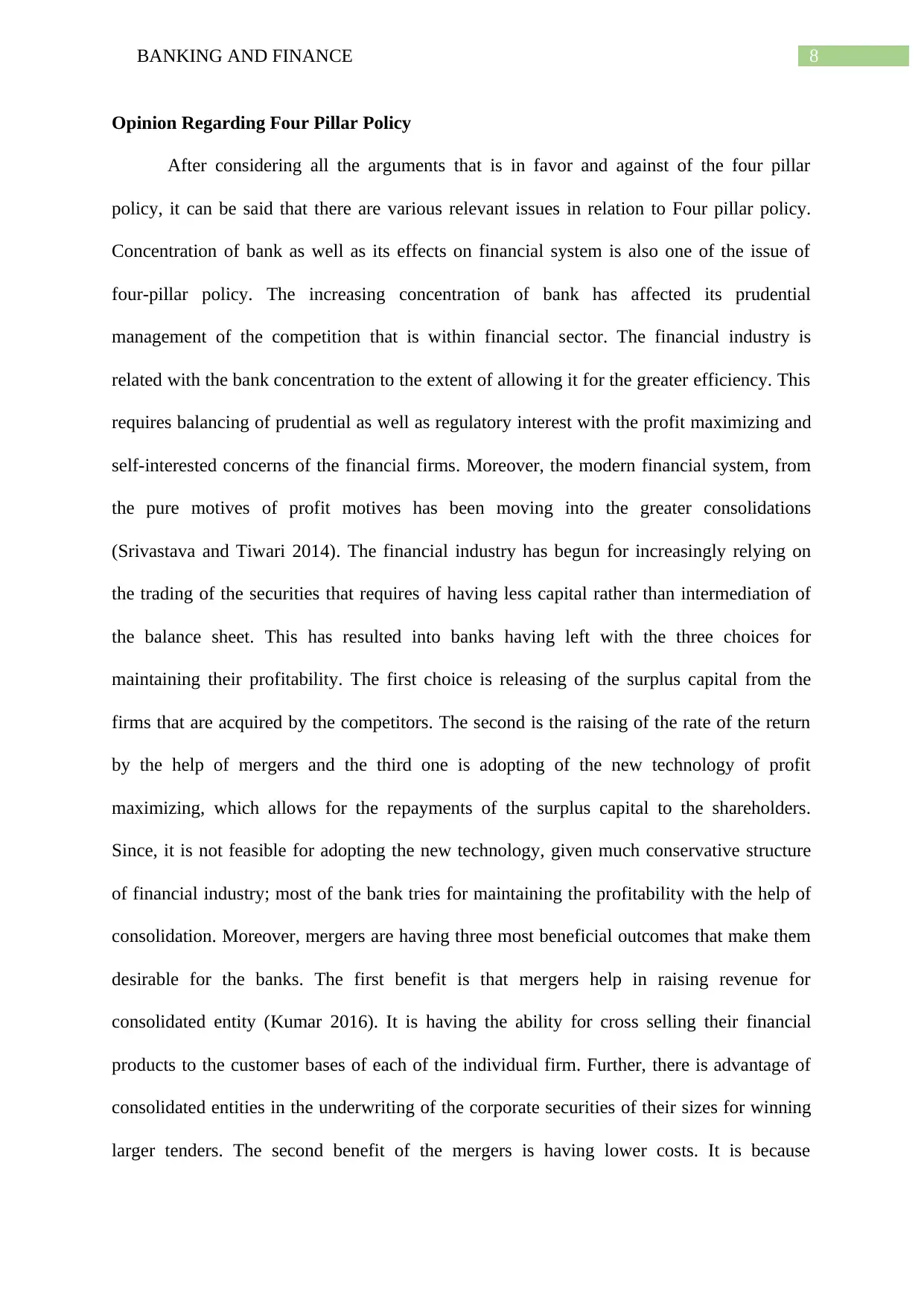
8BANKING AND FINANCE
Opinion Regarding Four Pillar Policy
After considering all the arguments that is in favor and against of the four pillar
policy, it can be said that there are various relevant issues in relation to Four pillar policy.
Concentration of bank as well as its effects on financial system is also one of the issue of
four-pillar policy. The increasing concentration of bank has affected its prudential
management of the competition that is within financial sector. The financial industry is
related with the bank concentration to the extent of allowing it for the greater efficiency. This
requires balancing of prudential as well as regulatory interest with the profit maximizing and
self-interested concerns of the financial firms. Moreover, the modern financial system, from
the pure motives of profit motives has been moving into the greater consolidations
(Srivastava and Tiwari 2014). The financial industry has begun for increasingly relying on
the trading of the securities that requires of having less capital rather than intermediation of
the balance sheet. This has resulted into banks having left with the three choices for
maintaining their profitability. The first choice is releasing of the surplus capital from the
firms that are acquired by the competitors. The second is the raising of the rate of the return
by the help of mergers and the third one is adopting of the new technology of profit
maximizing, which allows for the repayments of the surplus capital to the shareholders.
Since, it is not feasible for adopting the new technology, given much conservative structure
of financial industry; most of the bank tries for maintaining the profitability with the help of
consolidation. Moreover, mergers are having three most beneficial outcomes that make them
desirable for the banks. The first benefit is that mergers help in raising revenue for
consolidated entity (Kumar 2016). It is having the ability for cross selling their financial
products to the customer bases of each of the individual firm. Further, there is advantage of
consolidated entities in the underwriting of the corporate securities of their sizes for winning
larger tenders. The second benefit of the mergers is having lower costs. It is because
Opinion Regarding Four Pillar Policy
After considering all the arguments that is in favor and against of the four pillar
policy, it can be said that there are various relevant issues in relation to Four pillar policy.
Concentration of bank as well as its effects on financial system is also one of the issue of
four-pillar policy. The increasing concentration of bank has affected its prudential
management of the competition that is within financial sector. The financial industry is
related with the bank concentration to the extent of allowing it for the greater efficiency. This
requires balancing of prudential as well as regulatory interest with the profit maximizing and
self-interested concerns of the financial firms. Moreover, the modern financial system, from
the pure motives of profit motives has been moving into the greater consolidations
(Srivastava and Tiwari 2014). The financial industry has begun for increasingly relying on
the trading of the securities that requires of having less capital rather than intermediation of
the balance sheet. This has resulted into banks having left with the three choices for
maintaining their profitability. The first choice is releasing of the surplus capital from the
firms that are acquired by the competitors. The second is the raising of the rate of the return
by the help of mergers and the third one is adopting of the new technology of profit
maximizing, which allows for the repayments of the surplus capital to the shareholders.
Since, it is not feasible for adopting the new technology, given much conservative structure
of financial industry; most of the bank tries for maintaining the profitability with the help of
consolidation. Moreover, mergers are having three most beneficial outcomes that make them
desirable for the banks. The first benefit is that mergers help in raising revenue for
consolidated entity (Kumar 2016). It is having the ability for cross selling their financial
products to the customer bases of each of the individual firm. Further, there is advantage of
consolidated entities in the underwriting of the corporate securities of their sizes for winning
larger tenders. The second benefit of the mergers is having lower costs. It is because
⊘ This is a preview!⊘
Do you want full access?
Subscribe today to unlock all pages.

Trusted by 1+ million students worldwide
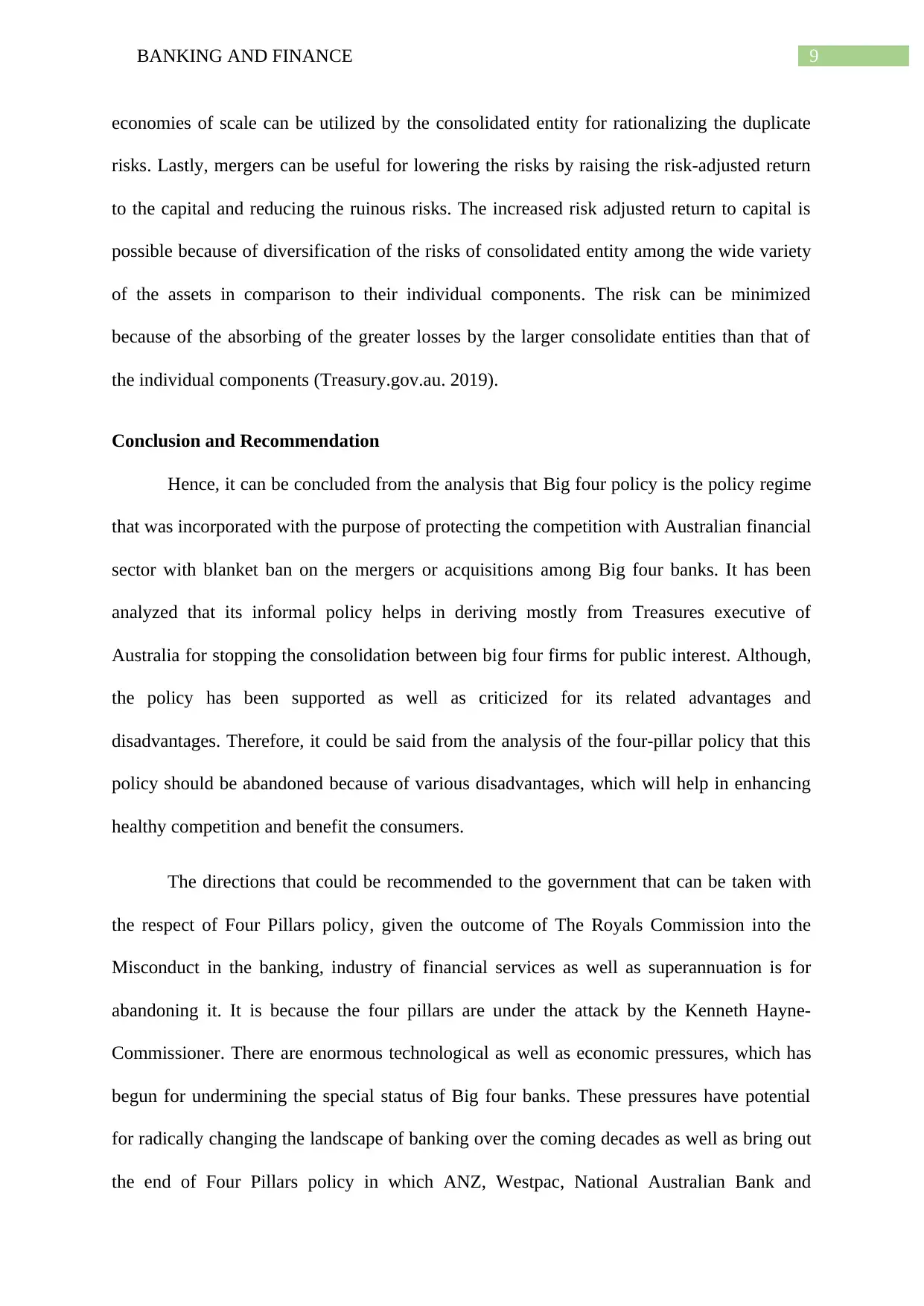
9BANKING AND FINANCE
economies of scale can be utilized by the consolidated entity for rationalizing the duplicate
risks. Lastly, mergers can be useful for lowering the risks by raising the risk-adjusted return
to the capital and reducing the ruinous risks. The increased risk adjusted return to capital is
possible because of diversification of the risks of consolidated entity among the wide variety
of the assets in comparison to their individual components. The risk can be minimized
because of the absorbing of the greater losses by the larger consolidate entities than that of
the individual components (Treasury.gov.au. 2019).
Conclusion and Recommendation
Hence, it can be concluded from the analysis that Big four policy is the policy regime
that was incorporated with the purpose of protecting the competition with Australian financial
sector with blanket ban on the mergers or acquisitions among Big four banks. It has been
analyzed that its informal policy helps in deriving mostly from Treasures executive of
Australia for stopping the consolidation between big four firms for public interest. Although,
the policy has been supported as well as criticized for its related advantages and
disadvantages. Therefore, it could be said from the analysis of the four-pillar policy that this
policy should be abandoned because of various disadvantages, which will help in enhancing
healthy competition and benefit the consumers.
The directions that could be recommended to the government that can be taken with
the respect of Four Pillars policy, given the outcome of The Royals Commission into the
Misconduct in the banking, industry of financial services as well as superannuation is for
abandoning it. It is because the four pillars are under the attack by the Kenneth Hayne-
Commissioner. There are enormous technological as well as economic pressures, which has
begun for undermining the special status of Big four banks. These pressures have potential
for radically changing the landscape of banking over the coming decades as well as bring out
the end of Four Pillars policy in which ANZ, Westpac, National Australian Bank and
economies of scale can be utilized by the consolidated entity for rationalizing the duplicate
risks. Lastly, mergers can be useful for lowering the risks by raising the risk-adjusted return
to the capital and reducing the ruinous risks. The increased risk adjusted return to capital is
possible because of diversification of the risks of consolidated entity among the wide variety
of the assets in comparison to their individual components. The risk can be minimized
because of the absorbing of the greater losses by the larger consolidate entities than that of
the individual components (Treasury.gov.au. 2019).
Conclusion and Recommendation
Hence, it can be concluded from the analysis that Big four policy is the policy regime
that was incorporated with the purpose of protecting the competition with Australian financial
sector with blanket ban on the mergers or acquisitions among Big four banks. It has been
analyzed that its informal policy helps in deriving mostly from Treasures executive of
Australia for stopping the consolidation between big four firms for public interest. Although,
the policy has been supported as well as criticized for its related advantages and
disadvantages. Therefore, it could be said from the analysis of the four-pillar policy that this
policy should be abandoned because of various disadvantages, which will help in enhancing
healthy competition and benefit the consumers.
The directions that could be recommended to the government that can be taken with
the respect of Four Pillars policy, given the outcome of The Royals Commission into the
Misconduct in the banking, industry of financial services as well as superannuation is for
abandoning it. It is because the four pillars are under the attack by the Kenneth Hayne-
Commissioner. There are enormous technological as well as economic pressures, which has
begun for undermining the special status of Big four banks. These pressures have potential
for radically changing the landscape of banking over the coming decades as well as bring out
the end of Four Pillars policy in which ANZ, Westpac, National Australian Bank and
Paraphrase This Document
Need a fresh take? Get an instant paraphrase of this document with our AI Paraphraser

10BANKING AND FINANCE
Commonwealth bank have continuously protected from any kind of threat against takeover
and prevention from merger. In future, with big four banks operating in the small and volatile
market may be pressurized for continuing the unacceptable practices, especially if the
pressure is increased by Reserve bank that requires that banks should lend more prudently.
Hence, with abandoning the four pillars policy, healthy competition will be increased by
encouraging more competition for the benefits of the consumers.
Commonwealth bank have continuously protected from any kind of threat against takeover
and prevention from merger. In future, with big four banks operating in the small and volatile
market may be pressurized for continuing the unacceptable practices, especially if the
pressure is increased by Reserve bank that requires that banks should lend more prudently.
Hence, with abandoning the four pillars policy, healthy competition will be increased by
encouraging more competition for the benefits of the consumers.

11BANKING AND FINANCE
Reference
ABC News. 2018. Four pillars banking policy should be 'put in the cupboard': Productivity
Commission. [online] Available at: https://www.abc.net.au/news/2018-02-07/productivity-
commission-warns-four-pillars-banking-policy-ad-hoc/9402742 [Accessed 30 Aug. 2019].
Apergis, N. and Cooray, A., 2015. Asymmetric interest rate pass-through in the US, the UK
and Australia: New evidence from selected individual banks. Journal of
Macroeconomics, 45, pp.155-172.
Bollen, B., Skully, M.T. and Wei, X., 2014. Basel capital adequacy agreements and bank
risk: Some Australian evidence. In 2014 Financial Markets & Corporate Governance
Conference.
Financialservices.royalcommission.gov.au. 2019. Financial Services Royal Commission -
Home . [online] Available at:
https://financialservices.royalcommission.gov.au/Pages/default.aspx [Accessed 30 Aug.
2019].
Geddie, K., 2015. Policy mobilities in the race for talent: Competitive state strategies in
international student mobility. Transactions of the Institute of British Geographers, 40(2),
pp.235-248.
Howes, M. and Dedekorkut-Howes, A., 2016. The rise and fall of climate adaptation
governance on the Gold Coast, Australia. Climate adaptation governance theory, concepts
and praxis in cities and regions.
Kumar, B., 2016. An Overview of the Banking Sector Consolidation in India: A Conceptual
Framework. Available at SSRN 2835870.
Reference
ABC News. 2018. Four pillars banking policy should be 'put in the cupboard': Productivity
Commission. [online] Available at: https://www.abc.net.au/news/2018-02-07/productivity-
commission-warns-four-pillars-banking-policy-ad-hoc/9402742 [Accessed 30 Aug. 2019].
Apergis, N. and Cooray, A., 2015. Asymmetric interest rate pass-through in the US, the UK
and Australia: New evidence from selected individual banks. Journal of
Macroeconomics, 45, pp.155-172.
Bollen, B., Skully, M.T. and Wei, X., 2014. Basel capital adequacy agreements and bank
risk: Some Australian evidence. In 2014 Financial Markets & Corporate Governance
Conference.
Financialservices.royalcommission.gov.au. 2019. Financial Services Royal Commission -
Home . [online] Available at:
https://financialservices.royalcommission.gov.au/Pages/default.aspx [Accessed 30 Aug.
2019].
Geddie, K., 2015. Policy mobilities in the race for talent: Competitive state strategies in
international student mobility. Transactions of the Institute of British Geographers, 40(2),
pp.235-248.
Howes, M. and Dedekorkut-Howes, A., 2016. The rise and fall of climate adaptation
governance on the Gold Coast, Australia. Climate adaptation governance theory, concepts
and praxis in cities and regions.
Kumar, B., 2016. An Overview of the Banking Sector Consolidation in India: A Conceptual
Framework. Available at SSRN 2835870.
⊘ This is a preview!⊘
Do you want full access?
Subscribe today to unlock all pages.

Trusted by 1+ million students worldwide
1 out of 14
Related Documents
Your All-in-One AI-Powered Toolkit for Academic Success.
+13062052269
info@desklib.com
Available 24*7 on WhatsApp / Email
![[object Object]](/_next/static/media/star-bottom.7253800d.svg)
Unlock your academic potential
Copyright © 2020–2025 A2Z Services. All Rights Reserved. Developed and managed by ZUCOL.





